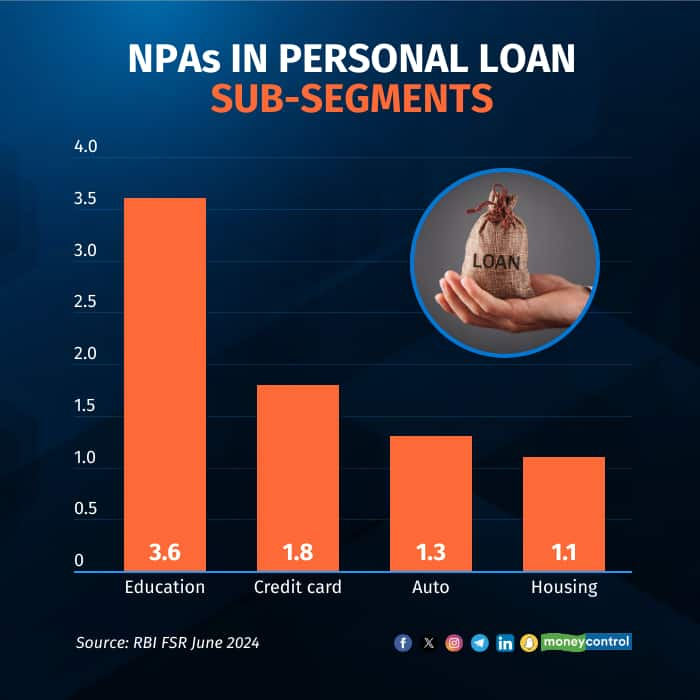



Bad debt is on the rise in the personal loans space, with defaults reaching the highest in the education segment and lowest in housing, according to an RBI report.
Non-performing assets (NPA) in education personal loans stood at 3.6 percent, compared to 1.8 percent in credit cards, 1.3 percent in auto loans and 1.1 percent in housing loans, the central bank’s Financial Stability Report (FSR) for June 2024 showed.
Experts highlighted that education loans see a jump as more students opt for studies abroad. “Education loans see a jump during the peak season and this at times leads to default and rise in the NPA too,” they said.
The central bank’s report highlighted that there has been a broad-based improvement in the asset quality of SCBs across personal loan segments.

“The GNPA ratio in all categories of personal loans reduced across bank groups. Within the industrial sector, asset quality improved across all major sub-sectors, barring the vehicles and transport equipment sector,” the FSR said.
Banks, according to the FSR, have been reporting an improvement in asset quality. “Asset quality continues to improve and capital positions remain robust, supported by capitalisation of high profits, the latter reflected in close to a decadal high levels of return on equity and return on assets ratios,” it said.
How has growth in personal loans been?Lending to the housing segment under personal loans grew 36.5 percent in March 2024, highest among other sub-segments. Next in line was credit card which grew by 25.2 percent, education loans which grew by 20.5 percent, other personal loans grew by 19.9 percent, and vehicle and auto loans by 18.3 percent, the FSR report showed.
Personal loans accounted for over half of private bank credit growth, the FSR showed. “The expansion in personal loans was broad-based, led by housing loans and followed by other personal loans,” it said.
The RBI’s latest sectoral credit data showed the credit card outstandings jumped 23 percent on a year-on-year basis in April 2024, down from 31 percent last year. Growth in the retail loans category stood 17.1 percent in April 2024, compared to 25.7 percent a year ago.
The RBI had last year warned banks of aggressive growth in personal and unsecured loans. Governor Shaktikanta Das has flagged concerns over the surge in unsecured lending by banks. “Banks and NBFCs would be well advised to strengthen their internal surveillance mechanisms, address the build-up of risks, if any, and institute suitable safeguards in their own interest,” Das said at a press conference after the Monetary Policy Committee meeting earlier in October 2023.
A month later, the RBI increased risk weightages on certain loan categories of unsecured credit by 25 basis points to signal to lenders to slow down the pace of high growth and control stress.
This led to slowdown in growth of personal and unsecured loans of some banks and non-bank lenders. “Recent data suggest that there is a moderation in loans and advances in unsecured lending after the RBI flagged it last year,” Das said in his monetary policy statement on June 7.
Discover the latest Business News, Sensex, and Nifty updates. Obtain Personal Finance insights, tax queries, and expert opinions on Moneycontrol or download the Moneycontrol App to stay updated!
Find the best of Al News in one place, specially curated for you every weekend.
Stay on top of the latest tech trends and biggest startup news.